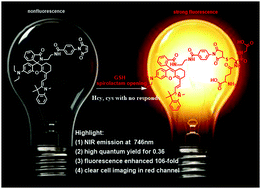A NIR facile, cell-compatible fluorescent sensor for glutathione based on Michael addition induced cascade spirolactam opening and its application in hepatocellular carcinoma†
Abstract
A NIR fluorescence probe with long emission wavelength at 746 nm and high quantum yield of 0.36 was designed and synthesized to selectively detect GSH over Hcy and Cys in living systems. 2-(1,3,3-Trimethylindolin-2-ylidene)acetaldehyde was attached to rhodamine by Knoevenagel condensation to shift the emission to near infrared region. Then, ethylenediamine was linked to M2 get an important intermediate M3. Finally, target molecule named RhNM was synthesized through combined N-[4-(carbonyl)phenyl] with M3. RhNM shows excellent discrimination in detecting GSH from Hcy/Cys along with an obvious color change. The fluorescence band at 746 nm is rapidly enhanced 106-fold after adding GSH, and the quantum was calculated at 0.36. Titration experiments of GSH showed good linear relationship of intensity vs. GSG concentration, and the detection limit was calculated at 70 nM. The proposed mechanism for identifying GSH based on Michael addition involves reactions of the carbon–carbon double bond and subsequent spirolactam opening. Meanwhile, the probe RhNM can work in a wide range of pH of 4–10. The probe RhNM was used for endogenous and exogenous imaging in HepG2 cells for glutathione. There was an outstanding intracellular red fluorescence occurring upon the addition of GSH incubated with HepG2 cells. It has been successfully applied for the determination of GSH in diluted serum and for bio-imaging of GSH in living cells with low cell toxicity. All results indicated that the probe can be used as an ultra-sensitive, near-infrared fluorescent chemical sensor for selectively detecting GSH in living cell. It has great potential in imaging of live tissues and even, animal imaging.



 Please wait while we load your content...
Please wait while we load your content...